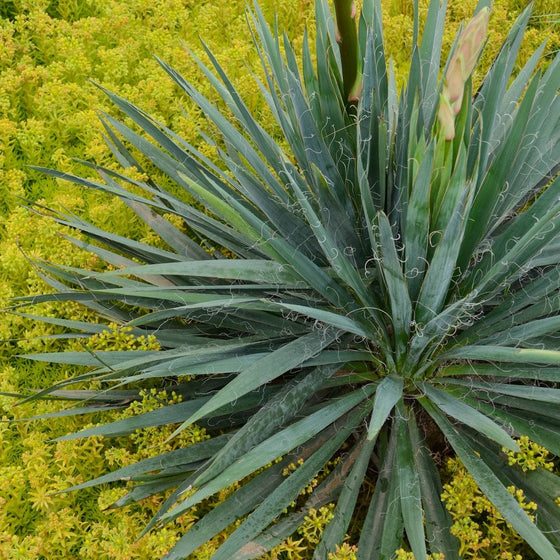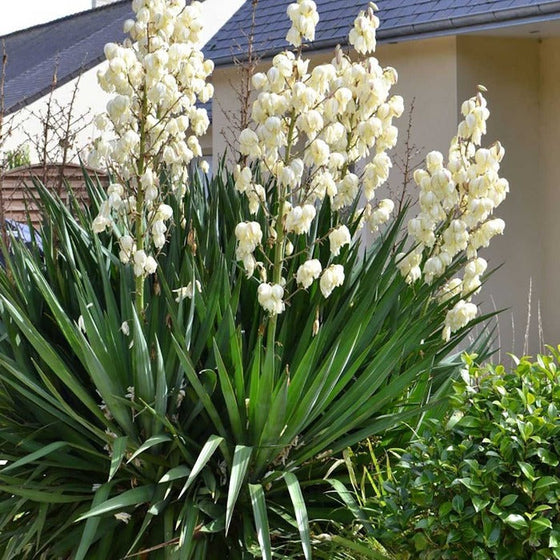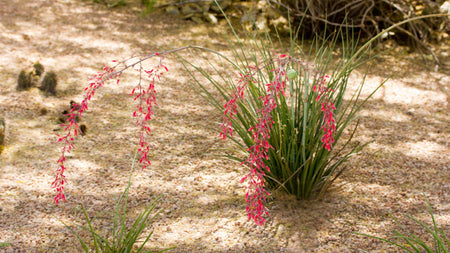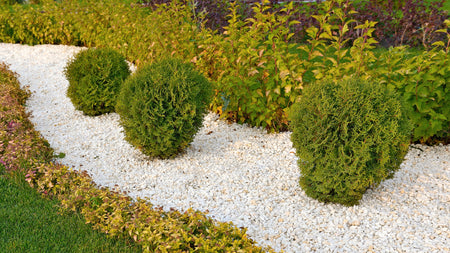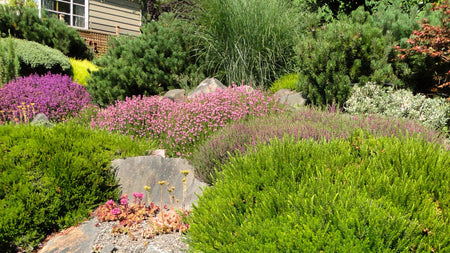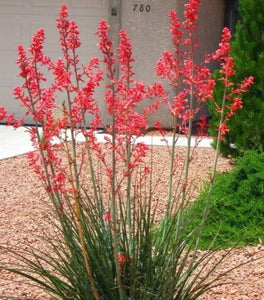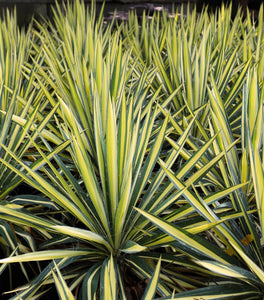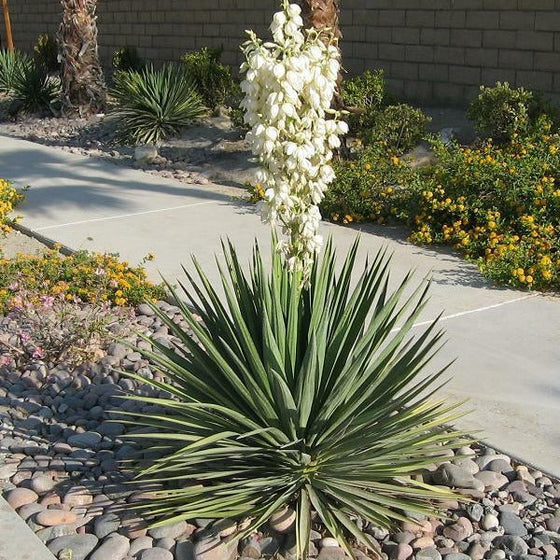
Images Depict Mature Plants
Yucca Excalibur for Sale Online
Yucca 'Excalibur' is a stunning, architectural, evergreen plant that brings a touch of the desert to your garden. With its striking blue-gray sword-like leaves, this yucca forms a dense, symmetrical rosette that adds bold texture and a unique visual element to any landscape. In summer, Yucca 'Excalibur' produces tall flower spikes adorned with clusters of creamy white, bell-shaped blooms, creating an eye-catching display that attracts pollinators such as bees and butterflies. Reaching a mature height of 3 to 4 feet with flower stalks that can soar up to 6 feet, this yucca is perfect for adding both height and texture to your garden.
Yucca 'Excalibur' thrives in full sun and well-drained soil, making it a low-maintenance choice for xeriscaping, rock gardens, and dry, sunny borders. It is highly drought-tolerant once established, making it an ideal option for water-wise gardening. Whether planted as a specimen plant, in groups for a striking visual effect, or as part of a mixed border, this yucca's bold, sword-shaped foliage provides year-round structure and interest. Its hardiness and resilience make it suitable for a wide range of climates, providing reliable architectural beauty even in challenging conditions.
In addition to its impressive ornamental value, Yucca 'Excalibur' is also deer-resistant and requires minimal care, making it an excellent choice for busy gardeners. Its spiky foliage helps deter deer and other browsing animals, while its deep root system ensures that it can withstand extended dry spells without the need for frequent watering. Plant Yucca 'Excalibur' in a well-drained location and enjoy its evergreen foliage and summer blooms as a standout feature in your garden. Whether you're creating a desert-inspired landscape or simply looking for a bold, easy-care plant, Yucca 'Excalibur' delivers striking beauty and durability year-round.

| Hardiness Zone: | 4-10 |
|---|---|
| Mature Height: | 2 to 3 feet |
| Mature Width: | 3 to 4 feet |
| Classification: | Broad Leaved evergreen shrub, Summer flowering |
| Sunlight: | Partial to Full Sun |
| Habit: | Upright, clump forming |
| Flower Color: | White |
| Foliage: | Blue |
| Pruning Season: | No Pruning Needed |
| Soil Condition: | Any well drained soil |
| Water Requirements: | Water well until established. |
| Uses: | Extremely attractive when used as a focal point in the mixed border, mass planting, or a hedge. Great winter interest due to evergreen habit. |
How to Care for Yucca Excalibur
Before purchasing your Yucca 'Excalibur', be sure to read the recommended care instructions to ensure your plant remains happy and healthy for years to come!
How Do I Plant A Yucca Excalibur?
To plant a Yucca 'Excalibur,' start by selecting a location that receives full sun, as this will help the plant thrive and develop its striking blue-gray foliage. Yucca 'Excalibur' is highly adaptable but performs best in well-drained soil—whether sandy, rocky, or loamy. Begin by digging a hole that is twice as wide as the root ball but just as deep. This allows the roots to spread comfortably without planting the yucca too deeply, which can lead to rot. Position the plant in the hole with the top of the root ball at or slightly above ground level. Backfill with the native soil, firming it gently around the roots, and water thoroughly to help the plant settle into its new location. Be sure to avoid overwatering, as Yucca 'Excalibur' is drought-tolerant and prefers drier conditions once established. After planting, apply a 2-3 inch layer of gravel or coarse mulch around the base of the yucca, but keep the mulch a few inches away from the trunk to prevent rot. This mulch will help retain some moisture, regulate soil temperature, and keep weeds at bay. Yucca 'Excalibur' requires minimal water once established, so it's important to allow the soil to dry out between waterings. Space multiple yuccas about 3-4 feet apart to create a bold, architectural display while allowing enough room for their mature size. By providing full sun, well-drained soil, and minimal watering, you can ensure that Yucca 'Excalibur' will flourish in your landscape, adding dramatic structure and unique desert-inspired beauty.
How Do I Water A Yucca Excalibur?
Watering Yucca 'Excalibur' properly is crucial for ensuring healthy growth, particularly during its initial establishment phase. In the first growing season after planting, water the yucca deeply once every 1-2 weeks to help establish a strong root system, making sure that the soil is allowed to dry out between waterings. This plant thrives in well-drained soil and does not tolerate soggy conditions, so avoid overwatering, as this can lead to root rot. When watering, use a slow, deep method to ensure moisture reaches the deeper roots. Once the top 2-3 inches of soil feel dry, it’s time to water again. This helps encourage deep root growth, which will improve the plant's overall drought tolerance. After Yucca 'Excalibur' is established, it becomes extremely drought-tolerant, requiring very little water. In most climates, natural rainfall will be sufficient, and supplemental watering is only needed during prolonged periods of drought or extreme heat. Be mindful that overwatering can harm mature yucca plants, so err on the side of caution and allow the soil to become completely dry before watering again. Yucca 'Excalibur' thrives in hot, dry conditions, making it an ideal low-maintenance option for xeriscaping, rock gardens, and other water-wise landscapes. By following these watering guidelines, you can ensure that your Yucca 'Excalibur' remains healthy, resilient, and continues to produce its beautiful blue-gray, sword-like foliage and stunning flower spikes.
How Do I Fertilize A Yucca Excalibur?
Fertilizing Yucca 'Excalibur' is relatively simple, as this low-maintenance plant does not require frequent feeding. In spring, apply a balanced, slow-release fertilizer, such as a 10-10-10 formula, to encourage healthy growth and enhance the vibrant blue-gray color of the foliage. Make sure to spread the fertilizer evenly around the base of the plant, focusing on the drip line—the area where the outermost leaves end, as this is where the roots actively absorb nutrients. Avoid applying fertilizer too close to the trunk, as this can cause damage to the plant. After fertilizing, water thoroughly to help the nutrients penetrate into the soil and reach the roots. This one-time spring feeding is usually sufficient to keep Yucca 'Excalibur' thriving throughout the growing season. If you prefer a more organic approach, adding compost or well-rotted manure around the base of the Yucca 'Excalibur' can provide a slow, steady supply of nutrients. In general, avoid over-fertilizing, as too much nitrogen can lead to lush green growth at the expense of the plant's structural integrity, causing the leaves to weaken and reducing the yucca's natural drought resistance. For the best results, ensure that the soil is well-drained and that the plant receives plenty of sunlight, as Yucca 'Excalibur' is a hardy plant that thrives under tough conditions. By providing moderate, appropriate fertilization, you can support healthy growth and ensure that your Yucca 'Excalibur' continues to be a bold and stunning feature in your landscape.

How Do I Prune A Yucca Excalibur?
Pruning Yucca 'Excalibur' is an essential part of maintaining its striking appearance and encouraging healthy growth. The best time to prune this yucca is in late winter or early spring, before new growth begins. Start by removing any dead, damaged, or discolored leaves from the base of the plant. These older leaves can become dry and brown over time, detracting from the plant's beauty and possibly harboring pests. Use clean, sharp pruning shears to cut these leaves as close to the trunk as possible without damaging the healthy tissue. Removing dead leaves not only improves the appearance of the plant but also allows for better air circulation, reducing the risk of disease. If your Yucca 'Excalibur' has produced tall flower stalks in the summer, you should also prune these after the flowers have faded. Once the flowering is complete, cut the stalks back to the base, as they will not bloom again and can detract from the plant's aesthetic appeal. Pruning spent flower stalks helps direct the plant's energy into maintaining its attractive blue-gray leaves and overall health. Be sure to wear gloves while pruning, as the sword-like leaves have sharp edges that can cause injury. By following these pruning practices, you can maintain the beautiful, architectural shape of Yucca 'Excalibur,' ensuring that it remains a bold and low-maintenance focal point in your garden.


